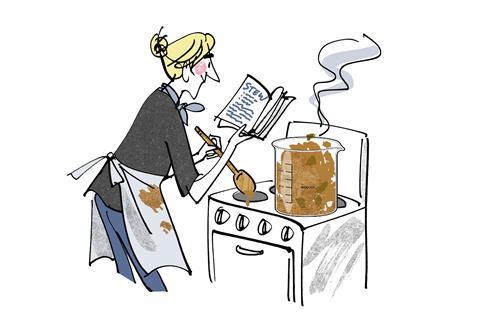An insight into the future of traditional meals

In my kitchen, there is a recipe book first used by my grandmother. It is full of family favourites, and over time, handwritten notes have been added to bring recipes up to date. Lines have been put through ‘aspic’, ‘beef dripping’, and ‘arrowroot’ with alternatives written alongside them: all with the ambition of delivering that same family favourite taste, with newer, better ingredients. It’s an evolving manual, not just a glimpse into history – but I wonder about the future. Would I feel confident enough to cross out the word ‘eggs’, replace it with ‘fermented cells’ and let the family know that they won’t be able to tell the difference?
That day may not be far away. According to the United Nations Environment Programme, in just under 30 years the global population will increase by two billion people and the volume of food we will need to sustain everybody will be at least 50% greater than what we produce now. An expanse of farmland twice the size of India will be required to accommodate the world’s food needs. Research into sustainable food and agricultural practices has two simple imperatives: to reduce the land dedicated for farming, and – while doing so – to reduce emissions.
These issues are especially relevant in countries such as Singapore, which have had to reassess their food security and take steps towards greater self-sufficiency since the breakdown of global supply chains during the pandemic. In Singapore’s case, space is a significant limiting factor, making many traditional farming practices impractical. But adversity often spurs innovation, and this is no exception. Around the world, solutions have surfaced, spanning industrial insect cultivation to lab-grown meat, and even calories directly synthesised from solar energy – an approach the company Solar Foods is taking, circumventing our reliance on photosynthesis.
Solar Foods makes its protein-based texture forming ingredient, Solein, by fermenting microorganisms, extracting key components for the process (water, nitrogen and carbon dioxide) from the air via electrolysis. This revolutionary food pathway renders previously inhospitable terrains, such as deserts, viable for Solein production. Electricity constitutes half of the production expenses of the process, but along with a few essential minerals, this is all the input needed to produce Solein. Given the company is named Solar Foods, it is perhaps unsurprising to learn that this electricity is to be produced through renewable means such as solar panels.
Solein aims to be a sustainable substitute for eggs and milk in manufactured foods. It made its debut in a restaurant in Singapore, where it was used in dishes including miso soup, pasta and ice cream – foods that one might find at any restaurant, or even in a family cookbook. It also has the potential to be used as a fortification ingredient to augment the nutritional content of some meals. The flavour and texture profile of Solein is designed to vanish within the dish, providing a more environmentally friendly alternative to plant and animal proteins that one wouldn’t be able to identify by taste.
Chemistry can play a role in capturing the nostalgia of food
One of the greatest barriers to new inventions like these is the sheer scale of the food industry. It is so large that any change is likely to take a huge amount of time and determination, especially if one considers the inertia currently apparent in the transition to green energy: a useful analogy. There is also the difficulty of teaching people how to cook with, and use, new food groups or categories. Novelty must balance with familiarity; new technologies with traditional tastes. Food in the future needs – in part – to be reminiscent of meals we have grown up loving.
Chemistry can play a role in capturing, not challenging, the nostalgia and tradition of food. Because chemistry can distil flavours down to their most basic components, tastes and textures can be reconstructed, ensuring that food traditions can live on even when the world and its resources are changing.
One of the biggest barriers to acceptance for these solutions comes from a misconception that there is a binary division between what is seen as natural, and therefore good; and what is seen as chemical, and therefore bad. Bad is also associated with non-traditional – as is the case in Italy, where the Senate passed legislation in July 2023 to ban all lab grown meat, seeing the sudden changes and pressures for alternative foods as a threat to its culinary heritage.
Even so, glimpses of progress emerge, underscoring the tangible impact of minor daily modifications, be it accepting different kinds of milk in one’s tea or companies like Solar Foods working with chefs to create food that is delicious and sustaining. Such incremental shifts collectively pave the way for accommodating the caloric needs of the next two billion inhabitants on our planet, while also making it possible to keep our beloved recipes – albeit with some imperceptible ingredient replacements.
Additional information
This article was produced in collaboration with the Creative Tuition Collective.
Creative Tuition Collective (CTC): Innovative and inclusive education is a non-profit organisation aiming to equalise the educational playing field. CTC strives to provide young people from low income backgrounds a free tuition service with holistic, high-quality tutoring, extracurricular opportunities and mental health support groups. With a passion and enthusiasm to teach and innovate education, CTC aims to not only develop the knowledge and self-assurance of young people in STEM but to also better prepare them for beyond the classroom. By assembling a diverse team within CTC along with specialist tutors, collaborating partners and invited speakers, CTC will tackle the lack of belonging, self-confidence and other barriers facing young people through an intersectional and progressive lens.












No comments yet